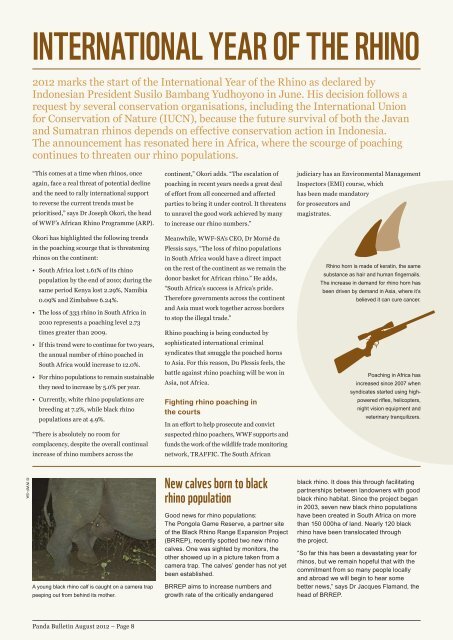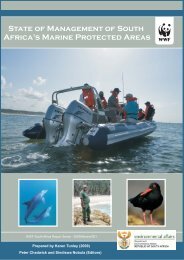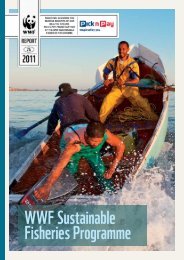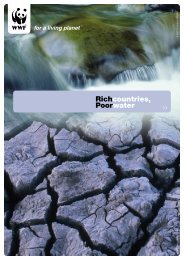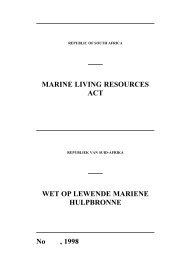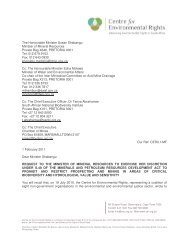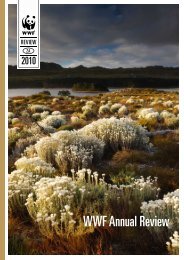Living Planet Report - WWF South Africa
Living Planet Report - WWF South Africa
Living Planet Report - WWF South Africa
You also want an ePaper? Increase the reach of your titles
YUMPU automatically turns print PDFs into web optimized ePapers that Google loves.
© <strong>WWF</strong>-SA<br />
INTERNATIONAL YEAR OF ThE RhINO<br />
2012 marks the start of the International Year of the Rhino as declared by<br />
Indonesian President Susilo Bambang Yudhoyono in June. His decision follows a<br />
request by several conservation organisations, including the International Union<br />
for Conservation of Nature (IUCN), because the future survival of both the Javan<br />
and Sumatran rhinos depends on effective conservation action in Indonesia.<br />
The announcement has resonated here in <strong>Africa</strong>, where the scourge of poaching<br />
continues to threaten our rhino populations.<br />
“This comes at a time when rhinos, once<br />
again, face a real threat of potential decline<br />
and the need to rally international support<br />
to reverse the current trends must be<br />
prioritised,” says Dr Joseph Okori, the head<br />
of <strong>WWF</strong>’s <strong>Africa</strong>n Rhino Programme (ARP).<br />
Okori has highlighted the following trends<br />
in the poaching scourge that is threatening<br />
rhinos on the continent:<br />
• <strong>South</strong> <strong>Africa</strong> lost 1.61% of its rhino<br />
population by the end of 2010; during the<br />
same period Kenya lost 2.29%, Namibia<br />
0.09% and Zimbabwe 6.24%.<br />
• The loss of 333 rhino in <strong>South</strong> <strong>Africa</strong> in<br />
2010 represents a poaching level 2.73<br />
times greater than 2009.<br />
• If this trend were to continue for two years,<br />
the annual number of rhino poached in<br />
<strong>South</strong> <strong>Africa</strong> would increase to 12.0%.<br />
• For rhino populations to remain sustainable<br />
they need to increase by 5.0% per year.<br />
• Currently, white rhino populations are<br />
breeding at 7.2%, while black rhino<br />
populations are at 4.9%.<br />
“There is absolutely no room for<br />
complacency, despite the overall continual<br />
increase of rhino numbers across the<br />
A young black rhino calf is caught on a camera trap<br />
peeping out from behind its mother.<br />
Panda Bulletin August 2012 – Page 8<br />
continent,” Okori adds. “The escalation of<br />
poaching in recent years needs a great deal<br />
of effort from all concerned and affected<br />
parties to bring it under control. It threatens<br />
to unravel the good work achieved by many<br />
to increase our rhino numbers.”<br />
Meanwhile, <strong>WWF</strong>-SA’s CEO, Dr Morné du<br />
Plessis says, “The loss of rhino populations<br />
in <strong>South</strong> <strong>Africa</strong> would have a direct impact<br />
on the rest of the continent as we remain the<br />
donor basket for <strong>Africa</strong>n rhino.” He adds,<br />
“<strong>South</strong> <strong>Africa</strong>’s success is <strong>Africa</strong>’s pride.<br />
Therefore governments across the continent<br />
and Asia must work together across borders<br />
to stop the illegal trade.”<br />
Rhino poaching is being conducted by<br />
sophisticated international criminal<br />
syndicates that smuggle the poached horns<br />
to Asia. For this reason, Du Plessis feels, the<br />
battle against rhino poaching will be won in<br />
Asia, not <strong>Africa</strong>.<br />
Fighting rhino poaching in<br />
the courts<br />
In an effort to help prosecute and convict<br />
suspected rhino poachers, <strong>WWF</strong> supports and<br />
funds the work of the wildlife trade monitoring<br />
network, TRAFFIC. The <strong>South</strong> <strong>Africa</strong>n<br />
New calves born to black<br />
rhino population<br />
Good news for rhino populations:<br />
The Pongola Game reserve, a partner site<br />
of the Black rhino range expansion Project<br />
(BrreP), recently spotted two new rhino<br />
calves. one was sighted by monitors, the<br />
other showed up in a picture taken from a<br />
camera trap. The calves’ gender has not yet<br />
been established.<br />
BrreP aims to increase numbers and<br />
growth rate of the critically endangered<br />
judiciary has an Environmental Management<br />
Inspectors (EMI) course, which<br />
has been made mandatory<br />
for prosecutors and<br />
magistrates.<br />
rhino horn is made of keratin, the same<br />
substance as hair and human fingernails.<br />
The increase in demand for rhino horn has<br />
been driven by demand in Asia, where it’s<br />
believed it can cure cancer.<br />
Poaching in <strong>Africa</strong> has<br />
increased since 2007 when<br />
syndicates started using high-<br />
powered rifles, helicopters,<br />
night vision equipment and<br />
veterinary tranquilizers.<br />
black rhino. it does this through facilitating<br />
partnerships between landowners with good<br />
black rhino habitat. Since the project began<br />
in 2003, seven new black rhino populations<br />
have been created in <strong>South</strong> <strong>Africa</strong> on more<br />
than 150 000ha of land. Nearly 120 black<br />
rhino have been translocated through<br />
the project.<br />
“So far this has been a devastating year for<br />
rhinos, but we remain hopeful that with the<br />
commitment from so many people locally<br />
and abroad we will begin to hear some<br />
better news,” says Dr Jacques Flamand, the<br />
head of BrreP.


